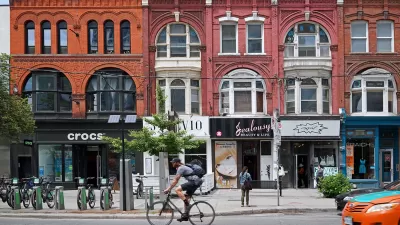Ken Greenberg, the former director of architecture and urban design for the city of Toronto, sits down to discuss how Toronto needs to transform to ensure a less auto-reliant future that serves a changing demographic of younger urban dwellers.

Toronto is at a crossroads according to the city's former director or architecture and urban design, Ken Greenberg. While the city continues to pour money into highway projects like the Gardner Expressway (saving a few commuters 2-3 minutes per day), newer residents in the city who have given up their cars (or never drove in the first place) aren't being adequately served. Luke Simcoe of Metro writes that Greenberg sees the city reacting too slowly to changes in consumer demand.
Greenberg, who helped revitalize Regent Park and is heading up the new Under Gardiner project, says the private sector has been quicker to adapt to the return of urbanism than city officials.
“Developers who are being driven by the market are providing fewer parking spaces in new buildings, for example,” he said. “We used to talk about two spaces for every unit and now we’re down in some places to one for every four units.”
Greenberg urged municipal leaders to follow suit, lest they cede their authority to developers or “disruptive” companies like Uber, Airbnb or Google.
Greenberg advises Toronto leaders to be less risk-adverse and take chances with new pilot programs with potential for positive change. "What a city really is is a giant R&D lab, full of trial and error. We need to embrace that..."
FULL STORY: 'The city is a giant R&D lab:' Architect and planner Ken Greenberg talks Toronto

Pennsylvania Mall Conversion Bill Passes House
If passed, the bill would promote the adaptive reuse of defunct commercial buildings.

Planning for Accessibility: Proximity is More Important than Mobility
Accessibility-based planning minimizes the distance that people must travel to reach desired services and activities. Measured this way, increased density can provide more total benefits than increased speeds.

World's Largest Wildlife Overpass In the Works in Los Angeles County
Caltrans will soon close half of the 101 Freeway in order to continue construction of the Wallis Annenberg Wildlife Crossing near Agoura Hills in Los Angeles County.

Colorado Bans No-Fault Evictions
In most cases, landlords must provide a just cause for evicting tenants.

Alaska Village Becomes Test Case for Climate Change Relocation
The Yup’ik village of Newtok is the first Alaska community to begin a full-scale relocation necessitated by the impacts of climate change. Another 31 Alaska communities remain vulnerable.

Amtrak Takes Lead on Texas Central Rail
The high-speed rail project isn’t a done deal, but if it moves forward, trains could begin operating in 2030.
City of Costa Mesa
Licking County
Barrett Planning Group LLC
HUD's Office of Policy Development and Research
Mpact Transit + Community
HUD's Office of Policy Development and Research
Tufts University, Department of Urban and Environmental Policy & Planning
City of Universal City TX
ULI Northwest Arkansas
Urban Design for Planners 1: Software Tools
This six-course series explores essential urban design concepts using open source software and equips planners with the tools they need to participate fully in the urban design process.
Planning for Universal Design
Learn the tools for implementing Universal Design in planning regulations.


























